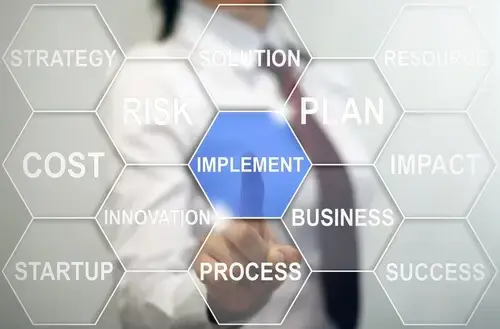How much does a Learning Management System cost?
A Learning Management System (LMS) is an indispensable tool for educational institutions and businesses to manage, deliver, and track learning content. Various cost aspects arise during the introduction, operation, and further development of an LMS.
Obviously, there can't be a blanket statement regarding the cost of a Learning Management System (LMS). License models, functional requirements, the number of learners, the supported processes and the desired services vary significantly.
In the following text, we have compiled various aspects for you to consider when comparing the costs and benefits of an LMS solution. This article will examine these aspects, introduce different licensing models, and explain their advantages and disadvantages.
Cost Aspects of a Learning Management System
A Learning Management System (LMS) or a Learning Experience Platform (LXP) incurs costs not only during implementation but also in terms of operation, maintenance, as well as customization and further development.
1. Implementation Costs
The implementation of an LMS involves the following costs:

a. License Costs
LMS providers often charge license fees for the use of their platform. Costs can vary from a simple open-source solution to expensive enterprise licenses.
b. Implementation Costs
Customizing the LMS to meet specific requirements and integrating it into existing systems requires professional services, incurring additional expenses.
c. Training Costs
Training employees or instructors to effectively use the LMS can result in expenses.
d. Content Development
Creating learning content, including text, videos, and interactive elements, can require a significant investment in authoring tools and curation.
2. Operating Costs
a. Hosting and Maintenance
The provisioning and maintenance of necessary hardware and software can be costly, especially if you opt for an on-premises solution. These costs may be relative if your company already has an existing IT infrastructure.
b. Support and Updates
LMS providers often offer support contracts and regular updates that come with monthly or annual fees.
c. Bandwidth and Storage
The costs for the required bandwidth and storage space depend on the number of users and data volume.
3. Development and Enhancement Costs
To keep the LMS up to date and meet changing requirements, adjustments and developments are necessary:
a. Customizations and Enhancements
Integrating new features or adapting to changing educational goals requires development work and associated costs. ► Choosing a system that allows customization of various settings independent of the manufacturer can contribute significantly to cost reduction.
b. System Integration
Technological advancements, increasing digitization, and the ongoing design of your learning environment through integration with other systems, web service-based connectivity, robots for data exchange, and interfaces can incur additional costs. ► Costs can be minimized by selecting a provider specializing in flexible learning architecture design or offering an Application Programming Interface (API).
c. Content Updates
Learning content must be regularly updated to remain relevant, incurring additional costs for the creation and updating of materials. ► Integrating external learning platforms can provide cost certainty, at least for standardized learning content.
License Models and Calculation Bases

- Single License Fee: With this model, you pay a one-time fee per user (training administrators/learners) or installation. Costs are predictable, but limited support and potentially outdated software may result.
- Subscription: In this model, you pay regular fees, typically per user or per month/year. It provides frequent access to support and updates but can be more expensive in the long run.
- Open Source: Open-source LMS are free in terms of license fees but require significantly more resources for implementation and maintenance. They often come with a basic installation, and customization through in-house development or agencies can be costly.
- Pay-as-you-go: Some providers offer usage-based billing. This offers flexibility but lacks cost predictability, posing potential risks.
ROI (Return on Investment) & ROE (Return on Education)
How can the benefit provided by an LMS be calculated?
Benefit Calculation of a Learning Management System
The benefit calculation for a Learning Management System (LMS) is crucial as it assesses the effectiveness and Return on Investment (ROI) of the LMS. It allows for identifying cost savings, efficiency improvements, and enhanced learning outcomes, highlighting the profitability and added value of the system for educational institutions and businesses.
It is important to delve into Return on Education (ROE) of the LMS, even though it may be relatively challenging to calculate, as it shifts the focus from purely financial gains to the broader educational and organizational benefits. Understanding the non-financial impact, such as improved employee satisfaction and performance, fosters a holistic perspective on the value of educational investments, driving long-term success.
ROI (Return on Investment)
ROI is calculated using the formula:
ROI = (Profit - Cost) / Cost x 100
For example, a company invests $10,000 in implementing an LMS but saves $15,000 in training costs in the first year. The ROI is calculated as:
ROI = (15,000 - 10,000) / 10,000 x 100 = 50%
This means that the company achieved a 50% return on its LMS investment in the first year.
ROE (Return on Education):
ROE focuses on non-financial outcomes and can be determined through surveys, performance indicators, and qualitative analyses.
For example, a company invests significantly in employee training to reduce the error rate in production. After the training, there are fewer machine failures, maintenance costs decrease, sales quotas rise due to higher-quality products, and employees identify more with the company, leading to a higher retention rate. These non-financial improvements can be measured in increased productivity and reduced costs, representing a positive ROE.
General Aspects of Benefits
- More Efficient Training: An LMS enables standardized training, reducing training costs.
- Time Savings: Automated processes for registrations, assessments, and reporting reduce administrative workload.
- Improved Trackability: The LMS allows monitoring learners' progress and identifying areas for improvement, which is particularly relevant in regulated industries (Compliance).
Specifically, product training is a significant lever for efficiency improvement and benefit maximization in the industry (Read the article: "Product Training in the Industry").
Summary & Conclusion
A Learning Management System (LMS) is a crucial tool for educational institutions and businesses, but it comes with various cost aspects. Implementation costs encompass licensing fees, implementation, training, and content development. Operating costs include hosting, maintenance, support, and bandwidth. Development costs arise from customizations and content updates.
There are different licensing models such as single licenses, subscriptions, open-source, and pay-as-you-go, each with its advantages and disadvantages.
The assessment of an LMS's benefits relies on efficiency gains, time savings, and improvements in tracking learning progress. ROI (Return on Investment) is calculated by comparing gains to costs. ROE (Return on Education) concerns non-financial outcomes like increased employee satisfaction.
Identifiable benefit parameters include savings in training costs, time savings, learning success, and compliance. An effective LMS can not only reduce costs but also enhance efficiency and learning outcomes, leading to a positive ROI and ROE.
Conclusion: The value of an LMS and a worthwhile investment primarily depends on choosing a system that meets your requirements. Therefore, careful selection and comprehensive testing are of fundamental importance.

About SoftDeCC
Since 1998 SoftDeCC is working closely with major training centers and academies. This results in a unique experience with training requirements.
Our Learning Management System is designed to adjust to individual corporate learning processes and address evolving challenges. More...

Free Professional Consultancy
We will be happy to discuss your LMS Challenge and share our experience with you.
Call +49 (0)89 / 3090 839 30 to arrange for your free consultancy appointment.
.webp)




